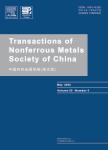版权所有:内蒙古大学图书馆 技术提供:维普资讯• 智图
内蒙古自治区呼和浩特市赛罕区大学西街235号 邮编: 010021

作者机构:State Key Laboratory of Powder MetallurgyCentral South UniversityChangsha 410083China The Third Xiangya HospitalCentral South UniversityChangsha 410013China Department of ProsthodonticsCentre of StomatologyXiangya HospitalCentral South UniversityChangsha 410008China Key Laboratory for Anisotropy and Texture of MaterialsMinistry of EducationSchool of Materials Science and EngineeringNortheastern UniversityShenyang 110819China Light Alloy Research InstituteCollege of Mechanical and Electrical EngineeringCentral South UniversityChangsha 410083China
出 版 物:《Transactions of Nonferrous Metals Society of China》 (中国有色金属学报(英文版))
年 卷 期:2025年第35卷第1期
页 面:143-156页
核心收录:
学科分类:08[工学] 0802[工学-机械工程] 080201[工学-机械制造及其自动化]
基 金:financially supported by the National Natural Science Foundation of China(No.51404302) the Natural Science Foundation of Hunan Province,China(Nos.2020JJ4732,2022JJ30897) the Natural Science Foundation of Changsha City,China(No.kq2202430)
主 题:selective laser melting Ti−3Cu alloy microstructure corrosion resistance antibacterial properties
摘 要:The corrosion resistance and antibacterial properties of Ti−3Cu alloy prepared by selective laser melting were evaluated using electrochemical experiments and a variety of antibacterial *** is found that the charge transfer resistance of Ti−3Cu alloy was 4.89×10^(5)Ω∙cm^(2),which was doubled the data obtained by CP-Ti *** antibacterial rates of Ti−3Cu alloy against *** and *** were 45.0%and 54.5%.And the antibacterial rates increased with the prolongation of cultivation time,reaching up to 62.8%and 68.6%,*** in-situ nano Ti_(2)Cu precipitates were homogeneously distributed in the matrix of the Ti−3Cu alloy,which was the key reason of increasing the corrosion ***,the microscale electric fields between theα-Ti matrix and the Ti_(2)Cu was responsible for the enhancement of the antibacterial properties.